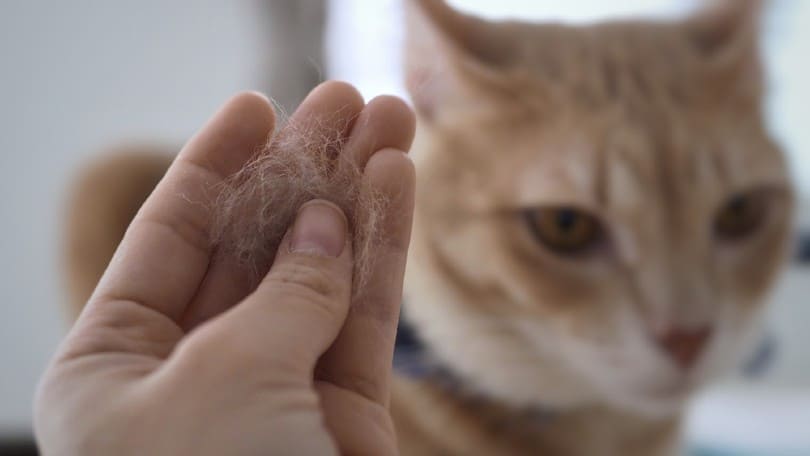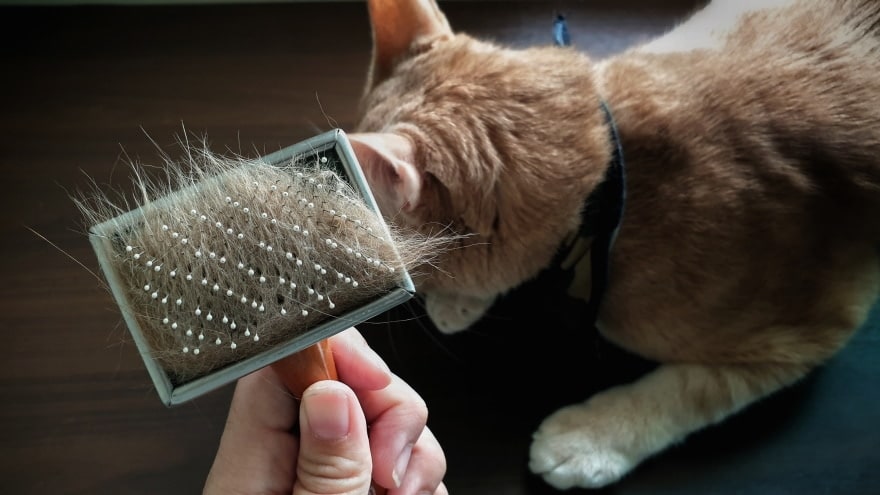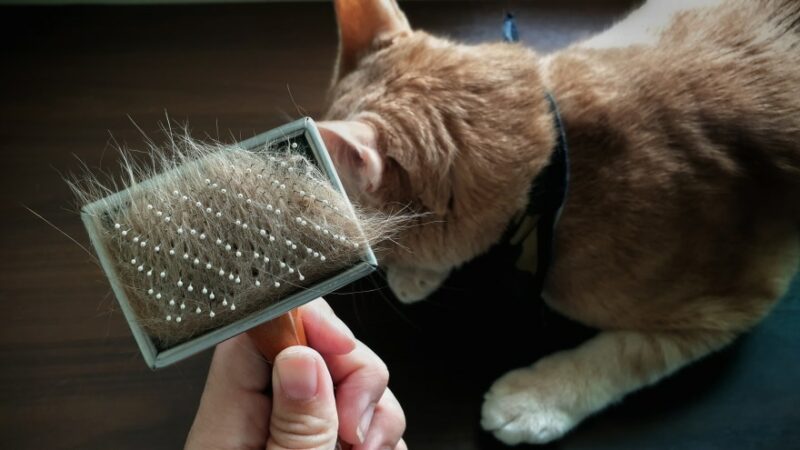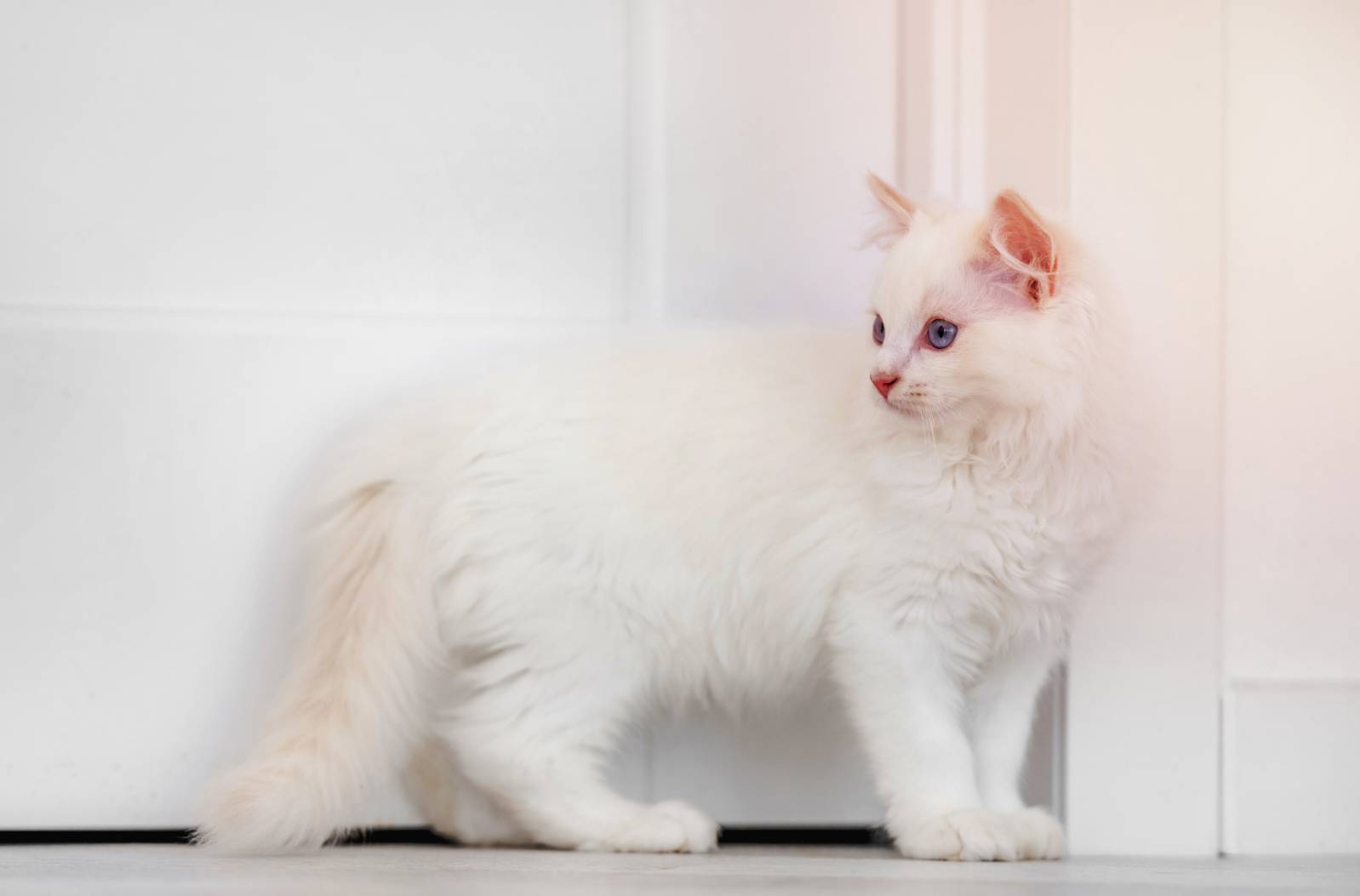Click to Skip Ahead
If you have a cat allergy, cat dander could be the culprit behind your symptoms. Dander is made of flakes of dead skin cells that have been shed. The dead skin cells are then replaced with healthy, living skin cells, which will eventually die and flake off, creating a steady accumulation of dander.
Unfortunately, all cats produce dander, so there is no getting around it if you have cat allergies. However, there are several ways to manage your allergies and live peacefully with a cat.
What Is Cat Dander?
Dander is the dead skin cells our cats shed, but why is it an allergen? The truth is that dander is not an allergen. Instead, it is a carrier for two different allergens. These allergens are called Fel d 1 and Fel d 4.
Fel d 1 and Fel d 4 are proteins. Fel d 1 is created by your cat’s skin and sebaceous glands, where it easily comes in contact with dying skin cells. On the other hand, Fel d 4 is produced within saliva. When your cat grooms, their saliva combines with the dander, and the Fel d 4 protein is transmitted through the dander.
Once the allergens are absorbed in the dander, they will be shed alongside the fur. This shedding can send allergens into the environment. Therefore, you are not reacting to the dander or hair if you have a cat allergy. You are responding to the proteins trapped within the dander.
Pet allergies can look very similar to seasonal allergies. Symptoms include an itchy throat, watering eyes, nasal congestion, swelling, and sneezing. In more severe cases, some people experience wheezing and difficulty breathing. You may also see changes in your skin, such as itchiness, eczema, or hives.

How to Deal With Cat Allergies
If you are uncertain whether you have cat allergies, consult your doctor. An allergen test can determine the source of your allergies. There are many allergens within our everyday environment, so it is possible that your cat is not responsible for your reactions after all. Once you discover the root of the issue, you can take steps to eliminate it or manage it.
If you have determined that your allergy is cat-related, there are some steps you can take to minimize your reactions. Purchasing an air purifier can do wonders for your allergies. Air purifiers filter the air’s allergens, helping you breathe more easily. However, they can be expensive, depending on the model you buy.
Brushing out your cat’s fur regularly can also reduce the amount of dander accumulating in their fur or your home. Likewise, occasionally bathing your cat or wiping their hair coat with water and a rag can remove dander or saliva in their fur.
Perhaps most importantly, clean your home frequently. Cleaning tight places such as shelves or corners of the room can reduce the build-up of dander, thus reducing the allergens in your environment. Carpets and rugs can trap dander and fur, but hardwood floors are easier to clean and hold less dander. If you clean your home regularly, you can minimize the amount of dander and hair wreaking havoc on your home.

Where Is Cat Dander Typically Found?
If you are wondering where cat allergens may be lurking in your home, the answer is everywhere. Cat allergens are microscopic. Since they are so small, they can quickly become airborne and travel far distances. That means the allergens can still travel to supposedly safe places even if you try to prevent your cat from entering certain rooms.
While cat dander can be found anywhere, it is most often in your cat’s favorite places. If they sit on the couch, the cushions will likely be full of allergens. It is also more likely to be in areas that do not get much cleaning or in places or objects that trap fur, such as carpets. If some areas in your home are more prone to accumulating cat allergens, be sure to target them when cleaning.
Advantages & Disadvantages of Cat Dander
Advantages of Cat Dander
For humans, the best we can hope for with cat dander is to be immune to it. In truth, the only good side to cat dander for us is that there is a potential for neutrality. However, for our cats, dander is needed.
Our cats must shed their old skin cells to replace them with newer, healthier ones. If they did not shed their dander, their skin and coat would become unhealthy. So, perhaps the main advantage is that the shedding of dander keeps our cats feeling their best.
Disadvantages of Cat Dander
Of course, the most obvious disadvantage to dander is the allergies associated with it. The symptoms can be unpleasant to deal with and cause significant discomfort. The symptom onset can vary between individuals depending on their sensitivity. Some people may gradually feel a reaction building over time, whereas others may experience unpleasant symptoms within minutes of entering the same room as a cat.
Disregarding cat allergies, dander can also require a lot of cleaning. When your cat sheds dander and fur, they deposit it around the home. The accumulation can create an unclean and undesirable living space if not taken care of.

Frequently Asked Questions
Are There Hypoallergenic Cats?
With all this talk about allergies, looking for a cat that won’t cause the same issues is tempting. But is there such a thing as a truly hypoallergenic cat? Sadly, the answer is no. Although hairless cats may offer a reprieve from the intensity of symptoms due to their lack of fur, they still carry allergens that can cause allergic reactions in people.
As mentioned, the proteins Fel d 1 and Fel d 4 are carried primarily through the skin and the saliva, not the fur. The fur acts as a vehicle to transport the allergens, but it is not the cause of the allergens. The dander can still travel without hair being shed, and the allergens can accumulate in your home with or without cat fur being involved.
Are There Differences in Dander Production Between Cat Breeds?
Dander production does not significantly change between cat breeds, though allergen production may. Some claim that a cat’s gender, fur color, and geographical location may also impact the number of allergens it produces. There are also suggestions that spayed and neutered cats may create less dander than intact cats. However, the conclusions of this research are mixed across the board.
Are There Medical Ways to Minimize Allergic Reactions?
If the brushing, bathing, and cleaning have not worked out for you, you may want a more medical solution. Thankfully, there are some options for you. You can purchase over-the-counter antihistamines, which help relieve mild symptoms. If the antihistamines don’t do the trick, talk to your doctor to determine if more specialized allergy medication suits you.
Allergy shots can also help; they allow your body to develop tolerance to the allergens. However, this option takes a lot of time. You will need around a year of weekly injections, followed by 3 to 5 years of monthly shots. But afterward, you should have no symptoms and require no medication.
Conclusion
Cat dander can be a pesky part of owning a cat, but it doesn’t have to be. Reducing allergic reactions can be as simple as sticking to a regular grooming and house cleaning schedule and taking the time to target areas of high allergen accumulation. We love our cats, and the last thing we want to do is be separated from them. Talk to your doctor about your next steps if you seek relief from your cat allergies.
Featured Image Credit: RJ22, Shutterstock













